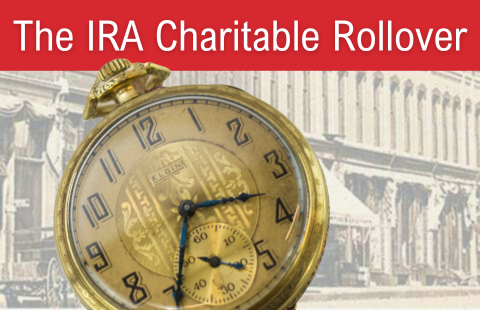Charitable IRA Rollover

Individual Retirement Account (IRA) owners age 70½ or over have th option to transfer up to $105,000 to charity tax-free each year. These transfers, known as qualified charitable distributions or QCDs, offer eligible older Americans a great way to easily give to charity before the end of the year. Moreover, for those who are age 73 and up, QCDs count toward the IRA owner's required minimum distribution (RMD) for the year.
What is an IRA charitable rollover?
The law uses the term “qualified charitable distribution” to describe an IRA charitable rollover. A qualified charitable distribution is money that individuals who are 70½ or older may direct from their traditional IRA to eligible charitable organizations. The provision has a cap of $105,000 for charitable distributions from individual IRAs each year. Individuals may exclude the amount distributed directly to an eligible charity from their gross income.
Is a donor limited to one IRA charitable distribution per year, or can a donor request multiple transfers?
Donors aged 70 ½ or older are limited to a maximum of $105,000 in any one year as an IRA charitable distribution, however there is no requirement that the entire amount be made in one transfer or that the entire amount go to a single qualified charitable organization. Donors can request multiple direct transfers from their IRA to qualified charities in a year, but only $105,000 will be excluded from income as an IRA qualified charitable distribution. For a married couple, if both spouses are age 70½ or over and both have IRAs, each spouse can exclude up to $105,000 for a total of up to $210,000 per year. The QCD option is available regardless of whether an eligible IRA owner itemizes deductions on Schedule A. Transferred amounts are not taxable, and no deduction is available for the transfer.
Under what circumstances will this special treatment of an IRA charitable rollover most likely benefit donors?
Generally, this new provision benefits donors who itemize deductions and whose charitable contributions are reduced by the percentage of income limitation. Traditionally, when individuals receive a distribution from their IRA and make a corresponding charitable contribution, they must count the distribution as income and then receive a charitable deduction for any amounts they transferred to charity. For higher income taxpayers, the charitable contribution deduction they receive may not totally offset the taxes they must pay for receiving the distribution from their IRA. In such cases, donors would potentially benefit more by using the charitable rollover provision when making a charitable donation.
Other donors who may benefit: individuals who do not usually itemize their deductions and individuals in states where the operation of state income tax law would offer greater benefits as a result of a charitable rollover. Donors will need to work with their professional advisers to determine the effect of these rules on their specific tax situation. This provision will also likely benefit donors whose charitable contributions are reduced by the itemized deduction reduction.
How do individuals make a qualified charitable distribution?
Individuals must instruct their IRA trustee to make the contribution directly to a charitable organization. Distributions may be directed to:
The Willa Cather Foundation
413 N. Webster St.
Red Cloud, NE 68970
